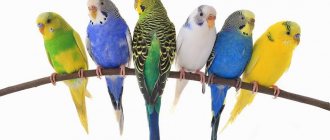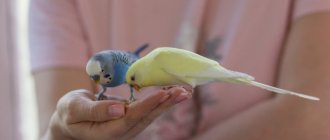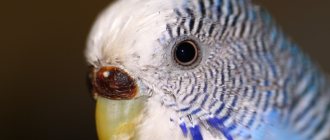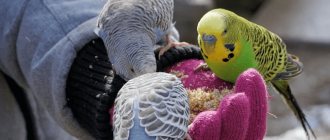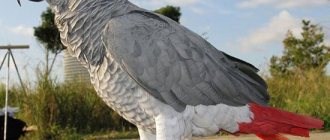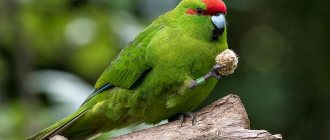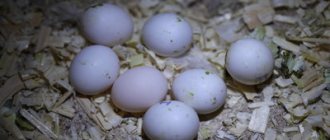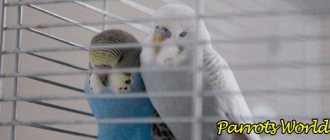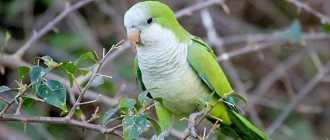Budgerigars are the birds that breeders love to work with. Counting the exact number of budgerigar species is incredibly difficult. There are many colors, shapes and colors of plumage. There are 32 primary mutations and more than a hundred secondary ones. Today we will talk about the most common breeds of wavy cats, and also look at several unusual colors.
Clear-winged parrot and lutino
White color with opaline pattern
This white variety was created by crossing an opaline and a white parakeet. The plumage color is completely white. The wings have a wavy gray pattern that forms a “V” when the wings are folded. On the shoulders, the feathers have a gap in the middle about 1 cm long; it is also called a “mirror.” This type of color also includes white yellow-faced opaline. This type of color also arose by crossing white-colored parrots with yellow-faced birds. These parrots have white plumage and a yellow mask. There is also a wavy gray pattern on the wings, in the form of the letter “V” when the wings are folded.
Varieties of colors
There are different types of colors of budgies. Let's look at them with you.
Standard color
Parrots that have this type of coloring look like this:
- their mask is lighter than their plumage;
- there are uniform stripes on the back;
- there are 6 throat spots.
Opaline coloring
Budgerigars that have this color have the following external features:
- They do not have uniform, clear stripes on the back and back of the head.
- The mask has a color that spreads across the front and top of the head. It is then covered by vaguely colored waves. The result of gradation is a mixture of the main and given colors.
- Often parrots that have this coloration have either dark gray or black markings on their wings. Sometimes these markings obscure the yellow or white pigment that dominates the bird's plumage.
Caring for white parrots
Having decided to breed white parrots, the first step is to form a pair that is capable of producing the necessary offspring. It must be taken into account that sometimes keeping in captivity leads to late attainment of sexual maturity in parrots. The ideal option would be to reproduce a setting similar to nature. Since parrots are white in color, it is best to mark the birds so that they can be distinguished. For example, small marks made with paint on the body of birds. A sure sign of pair formation is that the female allows herself to be fed by the male.
Parrots are usually bred in aviaries or cages. The best time for breeding is summer or early autumn, when there is a lot of light and warmth. If offspring are bred in winter, it is necessary to increase the duration of daylight to 15-16 hours a day, the room temperature should be 18-20°C, and there should be fresh greenery or tree branches in the cage.
It is not recommended to breed parrots in early spring. Birds are weakened after winter, and by spring, vegetables and fruits retain few vitamins and other essential substances. As a result of this, it is possible to obtain weakened offspring with reduced viability.
Next >www.popugaychik.com
Lutino - a cute bird for the home
Anyone who argues that lutino is the cutest bird to keep in apartment conditions can be called a liar. It is not surprising that keeping a really large but beautiful bird can be quite problematic, but it also happens that a small animal ends up being millions of times more expensive than an entire zoo. There will be no such problem with these birds!
Lutino is small in size. Thus, a birder will not need a large cage to maintain it. You won't need huge amounts of food and water either. Moreover, there will be no special conditions for the content. They are unpretentious and will get along under any circumstances.
When keeping a parrot, you must not forget about communication with the bird. This is the main parameter, without which the morale of the bird will go down the drain. When buying lutino, the owner must be prepared to talk with the bird. Cockatiels can be taught to talk - they, of course, will not enter into an intellectual dialogue, but they will surprisingly sweetly repeat what they can remember.
Lutinos are sun parrots. They remember well the intonation with which they are addressed. Therefore, you need to talk to them in a sing-song voice, affectionately, extending vowels.
How many years do budgies live?
Budgerigars live differently in captivity and in the wild. In captivity, depending on your luck. It’s all a matter of chance, it depends on whether the birds find food, whether they will be eaten by predators, whether they will not freeze, and on other unfavorable factors that affect life expectancy. Through scientific research, ornithologists were able to establish that, under favorable circumstances, budgerigars in the wild live from 3 to 5 years.
A bird in captivity is another matter. Here, only illness or poor care can interfere with life expectancy. If excellent conditions are created for her, she is fed a variety of foods, given bait, vitamins and all kinds of mineral supplements, then she can live long and happily. The average lifespan of a budgerigar is about 13-15 years. It happens that longer or shorter, less, mainly due to illness or improper care.
Budgerigars in the wild
In Australia, budgerigars still inhabit vast territories throughout the continent, only in the north and southwest they are almost absent, although over the last few decades they have already been seen there. They live in huge colonies along drying up rivers or along the shores of shallow lakes.
The flight of a flock of wild wavebirds is a breathtaking and amazing sight, because in a small colony (the name “small” is very arbitrary) there can be up to 100 birds, and in a large one – several times more! Building nests in the hollows of eucalyptus and other trees, budgerigars feed in nature on cereals and plant seeds. They drink a lot, so droughts, which often occur in Australia, are extremely dangerous for them.
Standard or common budgie
A direct descendant of the parrots brought by Cook from Australia, the standard (or ordinary) is a kind of exception to the rules of selection. It looks somewhat simpler than its wild ancestor, not as bright, stockier and not so graceful in figure. It is quite small - the body is about 7 cm without a tail.
The color of the body is light green, very bright; the head in front is yellow, and along the back of the head, transitioning to the back and cheeks, there are the famous waves of black and sand-colored stripes. Exactly the same stripes cover the wings; the tail may contain feathers of various shades.
The cere of standard budgerigars in males is blue or purple in youth, then darkens; in females it is blue, with white circles around the nostrils or light brown, and also acquires a dark shade with age. There are other options for coloring the waxwing, it all depends on the color of the bird. Standard budgerigars come in both green and bluish-blue base shades.
For example, a white and blue (variegated) parrot is a male, and to the left of him is a female.
Wavy Spangles
Spangles were created as a rare mutation of budgerigars and separated into a special subspecies. Among the common moths, individual specimens were observed in which the darker pigment was concentrated at the edges of the feathers.
Selecting birds for this trait, breeders persistently crossed them and achieved an unusual result: in a spangle, each feather has a dark, very noticeable edge. The unusual coloring of the feathers of Spangles creates a certain marbled effect; the birds are very original in appearance and unusually impressive. For example, as a result of these experiments, more and more often birds appear not with a black edging of feathers, but with a completely black body.
What stands out is the randomly obtained type of spangle - the so-called two-factor blue series. It is very similar to albino parrots, but its eyes are not red, but coal-black, and on its snow-white body there may be a barely noticeable grayish edging of each feather.
Lilac and purple budgies
They are very similar to the standard ones: the waves are located on the back of the head, cheeks and wings in the same way, but the black color alternates with white, not yellow. The body is uniformly colored purple and lilac.
A huge number of options have been developed, ranging from very light lilac to thick, very dark purple.
Variegated budgies
They come in two types - dominant and recessive (another name is Harlequins). Dominant motley parrots have a very noticeable feature of their species - there is always a brightly colored border on the abdomen. This border can be bright blue on a white background, or gray on white; a variant of the olive border is found in parrots with a yellow body.
Dominant mottled moths always have a spot of light-colored feathers on the top of their heads. The wings, the back of the head and the upper part of the back can be “wavy”, but there are also solid colors.
Recessive, or harlequins, also have areas of bright color against the general background, but they are not necessarily in the lower part of the abdomen, but can be anywhere - on the head, on the wings, on the chest, there are even specimens with such areas barely visible under the wings.
There are two-factor dominant parrots, which are difficult to immediately distinguish from recessive ones. They can be accurately identified either by their parents (recessive children can only have recessive children) or by the presence of an iris in adulthood. Dominant people have this iris.
Dominant Pied Parrots
Recessive pied parrots
Czechs, or show budgerigars
From the name it is not difficult to guess where these budgies, unusual in appearance and enjoying the greatest success at bird shows, were bred. The funny thing is that it is in the Czech Republic, which can be called the homeland of these birds, that they prefer not to call them Czechs, and their official name in this country is exhibition birds.
They are real giants when compared with other wavy species. Not only are they slightly larger than their simple wavy cousins; Czechs look more massive and stocky. Despite the fact that they are so large, it cannot be said that they are fat and awkward - the body is very harmoniously built, and besides, their posture is arrogant, simply royal.
How long show parrots (Czechs) live is not known for certain, since there is not much information about them. It is only noticed that their life expectancy is shorter than that of ordinary budgies. If the GDP parrot lives to be 7-8 years old, this already makes the owner happy. Often, after 4-5 years, breeding birds begin to have health problems (IMHO of the author of the article, based on personal experience in breeding “Czechs”).
Distinctive features
Exhibition budgerigars reach 29 cm, the standard is 24.5 cm. They have a fluffy cap on their heads, long beards and beautiful corals. But this is the case when the animal has a standard color. The beak hides the beard. The feathers have a proud attitude, the chest is stretched forward, and its head is held in such a way as if a winged friend were wearing a crown.
Plumage color
Colors may vary greatly. In addition, regular breeding is carried out in this direction. The exhibition of budgies can vary by type. These stunning, graceful birds are constantly improving. Every day there are different types of parrots.
Character
The feathered species of show parrots are calmer by nature. They don't chirp very often. However, they can speak a lot and clearly. In the morning their activity is quite low. They calmly wait for their owners to wake up. With a large body weight, show budgerigars fly very little, as they get tired quickly. However, it is very pleasant to have fun and communicate with them. Sometimes they can show their restless nature during the show. In this case, judges use special sticks that can be used to distract the bird and force it to sit for a moment.
Training and breeding
Show bird species are usually sold as tame birds. Therefore, it will be easier to teach them to speak. For training, you need to take a chick that has recently left the nest. Its age should be 40-50 days. It should be remembered that the longer a bird lives in a flock, the less chance it has of being tamed when it learns to speak.
Show parrots are less fertile. If we decide to breed them, separate enclosures should be prepared for each pair. Parents may stop feeding the chicks. This responsibility lies with the bird owner. Chickens are ringed with European standard rings. Serial number, year of hatching and country are required. Required for breeding and exhibition work.
The video will show how the parrot was tamed.
Show parrots require larger cages with thicker perches. Feeders should also be larger. Parrots can get stuck in regular ones and die from suffocation. The distance between the slats should not be more than 1.5 cm. Otherwise, a curious chicken will stick its head in and will not be able to pull it out. The litter box in the cage should be high so that the parrot can spread his wings.
Feed your exhibition parrot only high-quality dry food, vegetables, fruits, mineral stones, fresh water and vitamins. You can use honey sticks. Be sure to give sprouted wheat, first filling it with water. Lime curd is healthy.
The difference between GDP and a regular “wave”
The most important difference from other wavy representatives is the presence of a lush cap of feathers, which often looks like a real crown, and a beard of feathers under the beak. The hat can be small, very neat, it happens that it is no longer a hat, but a kind of punkish high crest, standing straight up in one clear bush; There are Czechs with a huge feather cap, which is larger than their head and can even hang over their eyes.
The feather beard of classic-colored Czechs is entirely covered along the lower edge as if with beads; this pattern consists of feathers of a darker, often black color.
There is an opinion that it is much easier to teach a Czech to speak than the rest of his relatives. Indeed, some representatives of this species begin to speak on their own, absolutely without training.
A little history
Parrots are one of the few representatives of the animal world that have survived to this day with an almost unchanged appearance. This is evidenced by numerous excavations of ancient human sites, during which fossil remains of this group of birds were discovered. Historical facts indicate that the Indians were the first to teach parrots to talk to people. Representatives of this group of birds appeared on the European continent along with the warriors of Alexander the Great. In those days, parrots were considered sacred because they could speak like humans. Later, these bright and energetic birds spread throughout Europe, gaining fame as favorite pets.
How many species of parrots are there today? The answer to this question is below.
Budgerigars of rare mutations
As a result of selective selection, very funny parrots with an unusual appearance were obtained; here are examples of some of these mutations. Crested (not to be confused with Czechs), who have a bush of feathers randomly sticking out in different directions on their heads. This crest can be small, consisting of just a few feathers, or it can be in the form of a semicircle or almost look like a neat cap. Rainbow wavy - they have a combination of a wide variety of colors, reminiscent of a rainbow in their brightness.
Anthracite ones are characterized by the fact that their body is dark gray in color. The spots on the cheeks are the same shade as the body. Half birds look so unusual that it’s hard to believe: was this bird really not painted, but it has its own coloring? The body of the half-wavy is two-colored, but it is divided into two different color sections strictly vertically.
To date, more than a hundred species of budgerigars have been registered, the ones listed above are the most popular and most interesting species. Scientific work on breeding new species brings people not only aesthetic pleasure: also in this regard, scientists have a wide field of activity in the field of studying the laws of heredity.
Video: exhibition budgerigars chicks.
pticadom.ru
It is believed that the white budgie, or as it is also called, an albino, is one of the most original types of budgies. Its appearance is both very unusual and beautiful. That is why albino is in good demand.
Many pet lovers would like to see such an unusual beauty in their cage, obtained by crossing different types of wavy animals. As you can easily guess from the name - albino, the entire color of the bird's plumage is white. However, if you look closely, you can see small shades of gray.
In itself, this species was obtained by crossing bird species such as lutinos and white budgerigars with a blue tint of feathers.
Another characteristic feature of this species of birds is that they have red eyes, characteristic of all varieties of albinos. Moreover, the paws of this type of parrot are light.
If you are interested in the difference between herself and an albino male, then distinguishing them is not so difficult. At first glance, it may seem to you that there are two completely identical birds in front of you. However, if you take a closer look at them, you will be able to notice that in some representatives of this species of birds the wax has a white tint. Others have a pronounced pink tint.
In this case, you can confidently say that in front of you are birds of different sexes. Females have a light-colored wax, while males have a pink one.
However, if you are interested in representatives of this species of birds, you will probably discover interesting news. In addition to the mentioned albinos, there is another type of white budgies, obtained by crossing species such as opalines and white parakeets.
This type of bird is characterized by a peculiar pattern formed by the folded wings of a bird at rest. Due to the fact that the wings of this bird have a slightly grayish tint, the resulting pattern looks like the Latin letter V.
popyga.ru
Breeding and selection
Back in 1805, an English traveler made a note about an unusual species of exotic birds living in Australia. Subsequently, more and more information about it became available, and as its popularity grew among exotic lovers, demand arose.
However, despite the huge number of attempts to export representatives of this species of birds to Europe, many of them ended in the death of the birds during transportation. However, some of them still found their new home as pets of many wealthy people.
Much later, after these budgerigars became more common as pets, breeders began to become interested in experimenting.
Thus, more than two hundred species of birds with different colors, patterns and feather shapes were gradually bred. Each of them was unique in its own way and unlike other subspecies.
However, in pursuit of the unique appearance of the parrot, it became obvious that birds bred through selective breeding have weaker immunity than their wild relatives. However, despite this, the demand for budgies with unusual coloring continued to grow.
Caring for a budgie
If you want to have such a pet in your apartment, it is best to buy young birds
. They get used to new conditions more easily, give birth to offspring faster, and, in addition, are much faster and more interesting than old, overstayed specimens. At the age of 4-5 months, male and female birds can already be fairly accurately identified.
The sex of budgerigars is distinguished by the color of the wax, this is the area just above the beak. In an adult male it is bright blue, in a young male, as well as white and yellow mutations it is pink, in females it is brown or whitish, in juvenile specimens it may be blue with white circles around the nostrils. Young parrots have a paler color, and the tip of the beak is black. The bottom photo clearly shows the difference in the color of the cere in the adult pair.
How to choose a parrot?
Signs of a healthy individual are smooth movements, tight-fitting feathers, and shiny, lively eyes. Lethargic and ruffled birds with wrinkled wax and beak and peeling on them should not be taken. They are either old or sick. It is also not recommended to purchase young parrots with poor plumage. These birds are bred from inbreeding and will never have a good appearance.
Proper nutrition, daily cleaning of the cage, good lighting, absence of cold and stuffiness - these are the main rules for caring for this bird.
The bright part of the room is best suited for keeping budgies. However, the cage should not be placed very close to the window to avoid a draft, which parrots, like other birds, are very afraid of, or near heating appliances. It is recommended to place the cage at human height. Smoking is prohibited where birds are located.
The duration of daylight hours should be 12-14 hours a day in summer and 10-12 hours in winter. On short days in autumn and winter, it is better to turn on electric lighting. For a room of 15-18 square meters. m requires illumination from lamps of 100-150 W, then the parrots will feel great and have time to eat the daily amount of food. In general, the more light, especially sunlight, the better feathered pets feel. In summer it can be taken out into the air and into light sun.
How to choose a cage?
The most suitable cages for feathered pets are rectangular cages with an upper part resembling a dome. Such houses can be made entirely or partially from metal.
So, one parrot needs an area of 35x35 cm, two parrots need at least 65x55 cm. The optimal cage dimensions are 60 cm in length and 40 cm in width. Since the height of the bird’s home is used only within the limits of movement along perches, ladders and hanging rings, its value is not critical. The cage can be higher or lower - this does not affect its level of comfort for your pet.
A bird living in an apartment with people really appreciates an excellent view. But on the other hand, the inhabitant of such a cage is exposed to drafts and does not have a reliable quiet corner where he could, if desired, retire. But this can be easily helped by darkening some area of the cage with plants or a curtain.
It is advisable to use all-metal cages for keeping parrots, since wooden cages suffer from these birds, especially when they lack fresh branches. In addition, in order to disinfect and prevent the development of parasites, the cells are scalded with boiling water once a month. The all-metal version is more resistant and durable in this regard.
Small tree branches attached to the walls of the “apartment” will help prevent this; the bird’s attention will switch to them.
You should not buy a house with very densely spaced rods. This will prevent the bird from observing its surroundings, and will also make it difficult for it to communicate with humans. It should be noted that the cage must be quite spacious so that the budgie can freely spread its wings, thereby partially making up for the lack of movement.
What to put in the cage?
1. One or two perches . They should be placed so that a sitting parrot does not stain water and food with droppings, and does not touch the bars with its tail.
2. Swing or freely swinging small ladder . The swing perches and ladders should be made of wood; it is best to use hard wood for these purposes: oak, beech, etc. Coniferous species are not suitable for these purposes, since they contain a substance that can cause the development of various diseases in birds.
3. Drinking bowl and feeders.
4. Bell with or without a mirror . can be bought at a pet store. As for the mirror, the opinions of the owners of budgies are divided. Some believe that the mirror has a bad effect on the “psyche” of the bird, as it stimulates the sexual reflex. However, this is not always justified; in any case, you can experiment - if you notice that the mirror has a bad effect on the bird, you can remove it. When learning to “speak,” it is advisable that there are no foreign objects in the bird’s cage. However, most “talking” birds display their vocabulary repertoire in front of a mirror.
5. A tray made of plywood or plastic with a grid
To prevent birds from eating food that has fallen on the floor and mixed with droppings, a metal grid with small cells should be attached at a height of 1.5-3 centimeters from the tray, but not so small that the bird could injure its paws. Such a grid will also help prevent damage to the pallet and extend its service life.
6. A special feeder with coarse sand , crushed eggshells, and charcoal. The budgie needs all these components for normal digestion. Parrots use it as a gastrolite - for grinding roughage in the stomach. The sand should not be fine - it only clogs the stomach without fulfilling its main function.
7. Cages with a hinged door must have a secure lock that the bird cannot open. Such devices can be carabiners, locks with keys and springs. If you don’t have the materials needed to make a lock at hand, you can use regular wire.
Cleaning the cage
Caring for parrots involves cleaning the cage daily.
It is necessary to remove debris, scrape off adhering dirt and litter from the sides, and brush off dust and debris with a soft brush. Having pulled out the tray, wipe it with a damp cloth and replace the bedding. Poultry dishes are washed with hot water with the addition of soda or special dishwashing solutions, then wiped dry. Feeders for grain mixtures are thoroughly cleaned of food residues, wiped with a clean cloth, filled with the daily amount of feed and put back in place. Wet feeders and drinkers are washed daily with hot water, and automatic drinkers are rinsed.
After normal daily cleaning, the cage is wiped with a damp sponge or cloth soaked in an infusion of wormwood or chamomile - thereby disinfecting its home harmlessly to the bird.
The cage should be completely cleaned at least once a week.
How to feed?
The main food is a grain mixture consisting of different varieties of millet, oats and canary seed. The grain mixture also includes flax seed, Abyssinian sesame nougat, hemp seed, meadow grass seeds, small sunflower seeds, etc. Pet stores now offer a large selection of different foods for these birds, and which one to choose is a personal matter for each owner and tastes parrot
But the owner must strictly monitor the quality of the feed. If you open a pack and see mold, dirt, or smell an unpleasant odor, you should under no circumstances feed it to your pet. Preference should be given to food in tightly sealed plastic packaging; in a cardboard box, food can deteriorate due to improper storage or transportation, and it does not prevent the penetration of insects and pests into it.
The optimal amount of food per budgerigar is approximately two teaspoons per day. Your feathered pet should completely eat all the food offered to it, and not select individual components from the grain mixture. You should not abuse various additional mixtures and treats, greatly diluting the main food with them. Remember that for normal nutrition of an animal, millet, as the main feed element, must make up at least half of its diet.
In addition to the grain mixture, budgies need to be given various additional foods: porridge, boiled chicken eggs, low-fat cottage cheese. The porridge must be crumbly, otherwise the parrots will not eat it. Birds eat well porridge made from crushed rice with the addition of millet. Parrots must be accustomed to this food from an early age, otherwise adult animals will eat it reluctantly.
They also love carrots, apples, dandelion leaves, wood lice, lettuce, and cabbage. Dandelion leaves, for example, are consumed fresh in finely chopped form from early spring until late autumn.
A hard-boiled fresh chicken egg is an excellent nutritious and vitamin-rich food for young budgerigars, as well as during the nesting period. It contains protein, fats, calcium, phosphorus, sodium and vitamins A, B, D. The egg should be boiled for 7-8 minutes. Finely chopped chicken egg mixed with semolina or crushed white breadcrumbs is given at the rate of 4-5 g per pet. The diet of budgerigars must contain mineral supplements high in calcium . The most common of these are egg shells, chalk, meat and bone and bone meal, as well as crushed calcium gluconate tablets. To improve the absorption of calcium and phosphorus, the bird’s body must have a sufficient amount of vitamin D.
In winter, you can sow oats, millet, canary seed, and young shoots in boxes, which are readily eaten by birds. This is done like this: pour soil into two 40x10x8 cm boxes and place them on the windowsill so that there is more light for greenery to grow. Sowing is carried out first in one box, and after 7-10 days, when the young shoots are 10-12 cm high, in the second. From the first box, the greens are collected in parts (as much as is needed per day), chopped and mixed with additional food or placed separately for feeding. As the greenery in the first box is consumed, it grows in the second, and the first is sown again. It turns out to be a so-called green conveyor until spring, when the first greenery appears.
There are some foods that definitely should not be given to your pet.
mango, persimmon, avocado, papaya, potatoes, parsley and other herbs, candied fruits, watermelon, melon.
Almonds and pistachios contain hydrocyanic acid and are also deadly to your parrot. Salted and pickled foods are not allowed, and much more.
As you can see, it is very easy to kill a parrot simply out of ignorance due to improper nutrition.
Pure water.
Drinking water must be clean, fresh, and at room temperature. Do not pour water from the tap - it contains harmful chlorine. It is useful to add special vitamin drops to the drinking bowl: VitaSol, Gamavit, Radostin and others.
During the cold season, add a little lemon juice to the water (1-2 drops per tablespoon of water). It helps improve the immune system of the budgerigar and also strengthens the plumage. In addition, lemon juice significantly disinfects water.
Many hobbyists use drinking water to give their parrots vitamin drops or powdered vitamin supplements.
www.liveinternet.ru
Conditions of detention
Keeping albino budgies is no different from keeping budgies of other colors. The minimum dimensions of a cage for one individual are 40x25x45 cm. The cage should be rectangular in shape with a flat top and have a retractable tray (this will make cleaning easier). Placed inside:
- perches - at least 2 pieces;
- drinking bowl;
- feeders for dry and wet food;
- bathing suit;
- toys.
On a note! The drinking bowl, bathing bowl, feeders and tray are washed every day, and other accessories - once a week. The cage is washed with water every week; once a month disinfection is carried out with chamomile infusion.
Settled or filtered water is poured into the drinking bowl. Feed is poured 2 times a day. The main part of the diet of budgerigars consists of grains: millet of various types (65%), oats (20%), canary seed (10%), plantain and dandelion seeds. The birds are also fed crumbly porridges of rice and millet, cooked in water without salt and sugar, grated carrots mixed with white bread crumbs, a boiled egg, low-fat cottage cheese, sprouted grains of oats, barley, wheat, and rye. Fruits, vegetables, berries, dandelion leaves, lettuce, wood lice are given in small quantities. Vitamin mixtures are added to the feed. Mineral supplements (chalk, crushed eggshells, shell rock, sepia) must be kept in the cage at all times. To grind off their claws and beaks, birds are given branches of willow and fruit trees.
Breeding budgies in captivity is not difficult. Healthy birds older than 14-16 months are selected as breeders. They are moved to a spacious cage at least 60 cm long. Daylight hours are increased to 14-16 hours, and the air temperature in the room is maintained above 20°C. The diet is enriched with sprouted grains, animal feed, herbs, fruits, vegetables, vitamin and mineral supplements.
A rectangular wooden nesting house measuring 17x17x23 cm with a tap hole 5 cm in diameter is hung in the cage. The bottom of the box is covered with a layer of sawdust.
If the birds are ready to breed, the male begins to care for the female and feed her, and the female begins to take an interest in the nesting house. A week after mating, the female lays 5-8 eggs, which she incubates for 18 days. At this time, the male feeds and protects her. The chicks fly out of the nest at the age of 35 days. They are left with their parents for another 14 days and then transferred to a separate cage.
Blue
First of all, it must be said that, surprisingly, the color diversity of budgies is a man-made phenomenon.
As a result, today blue parrots can be found, perhaps, even more often than green ones. They are welcoming and friendly creatures, and considering that the bluebird is a symbol of good luck, it is not surprising that this color is so popular among bird lovers.
Blue budgerigars were bred in France at the beginning of the twentieth century, although 25 years earlier Belgian breeders had already encountered similar mutations in the birds' colors.
Greens
It is not surprising that this color is the standard for an exotic bird. In the wild, budgerigars live in Australia, which is known as the green continent. No other colors will give small, defenseless birds a more reliable chance to get lost in the abundant tropical greenery and not become an accidental victim of a predator, and parrots have quite a lot of natural enemies, and they are quite dangerous.
A parrot has practically no chance of escaping from a kite or falcon, so the best way to protect itself is to remain unnoticed.
Light green
The main color of the "natural" budgerigar's plumage is that of young glossy grass, darker on the back and lighter green on the underparts, chest and belly. The bird has a light yellow mask on its head, six black spots on its throat plus two purple spots on the sides of its cheekbones. The entire back from the head itself and the wings are decorated with a motley black pattern in the form of wavy lines (hence the name of the bird). A special highlight is the dark blue central feathers on the wings and tail with a metallic tint. Sometimes the tail feathers are blue, and the flight feathers are black or dark green. The paws are greenish-gray.
However, as a result of domestication and long-term selection, a huge number of different types of shades of green budgies have been bred, bearing little resemblance to their original colors.
Dark green
Thus, at the beginning of the last century, dark green “wavy birds” were bred in France, which differ from their “natural” counterparts in a brighter and “festive” color, which in natural conditions the bird simply cannot afford to have.
In general, the distribution of colors in such parrots looks the same as in light green ones, but the main color of the plumage is darker, the yellow mask is a more saturated color, and the tail feathers, on the contrary, are of a less bright blue hue. The spots on the bird's throat are more purple than black.
Olive green
If dark green parrots are obtained by adding one dark factor to the natural color, then olive is formed by exposing a dark green bird to two dark factors at once. This is perhaps the most beautiful variation of all shades of green .
It’s difficult to describe it; it’s better to see it once: all the transitions, spots and waves are present, but their contrast is especially bright, and the main color is surprisingly saturated. The black color of the flight feathers has a distinct olive tint.
Description
The natural color of the budgerigar is green with a yellow head and a black wave-like pattern on the back and wings. Two pigments are involved in the formation of color: black (eumelanin) and yellow (psittacin). Eumelanin is responsible for the formation of the blue tint; together with the yellow pigment it gives green color.
If a bird's production of psittacin is impaired as a result of a genetic mutation, it acquires a blue color with a white head and a black pattern. If melanin is also not deposited in the feathers, they become pure white.
Disturbances in the deposition of pigments in feathers can be caused by mutations of various genes. Depending on this, there are three types of white budgies:
- dark-eyed pure white;
- two-factor white spangles;
- albino (ino mutation).
Dark-eyed pure parrots are obtained by combining two mutations: recessive pied and pied with pure flight feathers. Individually, these mutations cause partial leucism; in combination with each other they give a completely leucistic color. Such birds have pure white plumage; eyes are dark, legs are pink.
In Spangles, melanin deposition is reduced and the order of its distribution in feathers is disrupted. These birds also have a recessive modifier - the lightening factor. Birds that carry the spangle gene from both parents are called two-factor spangles. Their amount of melanin in feathers is less than that of single-factor feathers (that is, those obtained from crossing a spangle and a non-spangle), due to which the color of such parrots turns out to be monochromatic, without patterns or color inclusions. Two-factor white spangles have pure white plumage; The spots on the cheeks located on the sides of the beak are silvery-white (they are blue in wild parrots). The eyes are black with a white iris, the paws are gray or pink.
The ino mutation causes cessation of eumelanin production and also masks all other mutations (except cinnamon). Albino parrots are pure white in color; the eyes are red with a white iris, the paws are pink.
yellowface
A yellow “face” is a natural feature for a budgerigar, but blue birds with a yellow head are usually called yellow-faced, or simply yellow-faced. If the natural color of a bird, as we said, contains yellow and black colors, which amazingly give the illusion of green, then in order for yellow to become the main color, it is enough to simply remove the black pigment from the color. However, many breeders believe that yellow-faced parrots are not green birds without yellow, but blue birds with yellow, and discussions on this matter continue to this day.
There are three main types of yellow-faced budgies: type 1 and type 2, as well as the golden-faced, sometimes called the Australian.
European with normal pattern
This type of color has been known for more than 135 years. The bird has blue plumage throughout its body and its head is a pale lemon color. In the first type, the yellow color is practically absent from the body or occurs in the form of small, almost imperceptible streaks, sometimes visible in the feathers of the wings and tail. A separate variety is a bird with a very light yellow mask that looks almost white.
The second type of yellow-faced parrots is characterized by the presence of a lemon tint throughout the body, wings and tail. The main color of the feathers is at first bright azure, but during the molting process it increasingly approaches green. In this same variety, there may be an uneven proportion in the distribution of yellow and blue, resulting in the underparts of the bird appearing blue and the breast aqua green.
Australian normal
While European yellowfaces are characterized by shades similar to lemon, Australians associate it more with egg yolk. It is this tone that replaces white throughout the plumage: it is present on the flight feathers, in the tail, and on the body, as a result of which the bird looks green. As with European yellowfaces, in this case it is also possible to have a variation of uneven coloring of yellow and blue, as a result of which the lower part of the parrot is blue, and the upper part of the body is green.
In fact, the Australian coloration (golden-faced birds) is something intermediate between blue and green, and therefore this color is called “parblue” (partial blue), however, sometimes this term is also used in relation to European yellowfaces.
Genetics
In the wild (namely, in its homeland, in the tropical greenery of Australia), the budgie predominantly has green plumage (more precisely, light green), so that it can easily get lost in the grass and leaves of trees.
Interestingly, the appearance of green in this case is due to an optical illusion that distorts the yellow and black pigments that are present in bird plumage.
See the photo below for what a green budgerigar looks like.
The appearance of green coloring in parrots in their natural environment does not cause difficulties, since they are surrounded by relatives who have the same color. However, even in such circumstances, it may happen that the result of mating between a male and a female will be the birth of a parrot with a different plumage color from the parents. This phenomenon occurs when the parents of a chick pass on different hereditary characteristics to it. This is not good, since such a parrot becomes a noticeable target for predatory animals. Also, a flock may refuse to accept a stranger. Therefore, unfortunately, such unique birds do not live long in the wild.
Another thing is domestic budgies. They live comfortably, calmly, without fear of predators (unless, of course, there is some kind of “predatory animal” in the house, for example, a hunter cat) and have a wide variety of colors. Such a variety of different budgies became possible thanks to selection.
Gray
Adding a gray factor allows you to get several shades of gray. Depending on what color the bird is taken as the basis for breeding (green or blue), we get gray or gray-green individuals.
Gray (also called dominant or Australian grey) budgies can come in a variety of shades, but one of the rarest and most beautiful colors in this series is anthracite. The plumage of this bird is so dark that it appears black, sometimes with white splashes.
This coloring owes its appearance to German breeders, although in fairness it must be said that back in the 30s of the last century, gray parrots of a very dark shade were bred in England, however, unfortunately, this variety was not preserved (mainly due to the fact that that the dark gray color acted as a recessive factor in the genotype and was thus lost when crossed with any other individual).
Determination of gender
Determining the sex of white budgerigars can be difficult, since these birds have disturbed pigmentation of not only the plumage, but also the wax. As a result, the cere of males and females, especially at a young age, can have almost the same color.
- Where do budgerigars come from or Australia as the birthplace of the parrot
In adult dark-eyed pure white parrots and representatives of the albino morph, the cere of males is bright pink, sometimes with a lilac tint, and the cere of females is brown. The cere in boys of two-factor white spangles is blue, and in girls it is brown.
Gray-green
Gray-green budgies come in a variety of shades , from lighter to darker (brown).
Due to its close proximity to the natural color, this color was bred in the homeland of the “wavy”, in Australia. This happened in 1935. The birds have a mustard tint to the main plumage, the mask is a standard yellow color, and the black spots on the throat add a gray tint. The wavy stripes along the body are black and very contrasting, the flight feathers are green or black, and the tail is black.
Habitat
It just so happens that the natural color of the wavy birds living in Australia is green. It is thanks to him that the birds skillfully blend into the foliage surrounding them and become inconspicuous to the eyes of predators.
However, their colors are not monochromatic and differ in the content of colors such as black and yellow. Black color is present on the wings of the bird. The yellow color can be seen on the front part of the green tomboy.
The entire front part of the parrot's head is sort of one solid yellow spot. Against the background, which often stands out is a small purple spot, located symmetrically on both sides of his head.
This combination of colors and shades makes these nimble birds real masters of camouflage. At the same time, they never sit still and lead an active lifestyle.
At sunrise, the birds go in search of food, looking for grains of various plants and berries nearby. After the sun reaches its zenith and unbearable heat sets in, they gather in large noisy flocks on the treetops. They will fly out again in search of food only after the sun begins to set and it becomes a little cooler.
Mauve
Perhaps this is one of the most beautiful colors of a budgie. The bird looks surprisingly gentle and harmonious. Despite the fact that at first glance it appears to be light gray, in fact there is no gray tint in the plumage. Almost the entire body is evenly painted with a delicate mauve color without any streaks or inclusions. Under the beak there is a white mask with black dots, above the beak up to the forehead there is also a white area, turning into a series of black transverse stripes on the back of the head. There should be no other color splashes or patterns on the head.
general information
This bird species is not considered large. Since their length does not reach even twenty centimeters. At the same time, the weight fluctuates around fifty grams. However, despite such modest dimensions, these tomboys are real fidgets.
Sometimes it seems that budgies can talk non-stop for days on end. Taking a break just to have a snack. The name itself - budgerigar - was assigned to the bird for a reason.
If we translate the name of the bird from the Latin Metopsittacus undulatus, it turns out that it is a singing budgie. Moreover, by waves we mean a peculiar pattern on the bird’s back. It vaguely resembles waves, which was the reason for assigning such an unusual name to this species of birds.
Purple
The owner of a purple budgerigar can cause no less envy among neighbors. German breeders managed to obtain this color in the late 20s of the last century. It is based on the gray gene, which is dominant. Variations in plumage shades are also possible here - from purple as such to the delicate color of Persian lilac (the presence of a dark or blue factor, as well as the amount of purple - single or double) plays a decisive role.
According to approved standards, there are three shades of purple in the colors of budgies , although in reality there are at least six times more!
